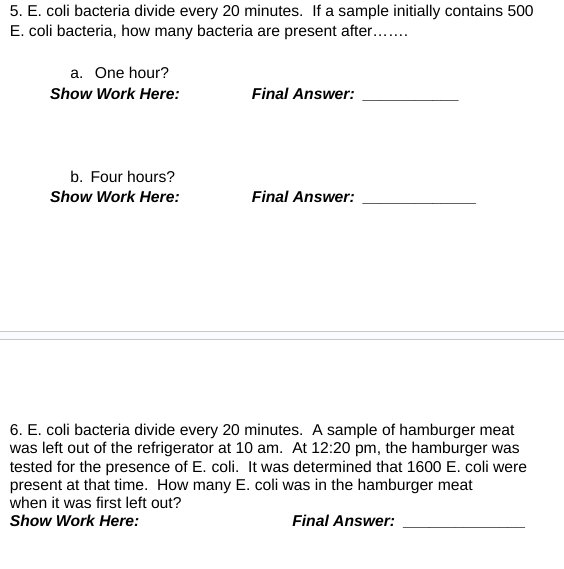E. coli bacteria divide every 20 minutes. A sample initially contains 500 bacteria. How many bacteria are present after one hour and after four hours? Additionally, if after a cert... E. coli bacteria divide every 20 minutes. A sample initially contains 500 bacteria. How many bacteria are present after one hour and after four hours? Additionally, if after a certain time left out of the refrigerator the count was 1600, how many were there initially?

Understand the Problem
The questions are asking how many E. coli bacteria are present after a certain time period given their division rate. Specifically, it asks for the bacterial count after one hour and after four hours, starting from an initial count of 500, as well as calculating the initial count based on the final count found after a certain time when left out of the refrigerator.
Answer
a. After one hour: $4000$ b. After four hours: $2048000$
Answer for screen readers
a. After one hour: 4000
b. After four hours: 2048000
Steps to Solve
-
Identify the division rate E. coli bacteria divide every 20 minutes. Therefore, in one hour (60 minutes), they will divide a total of: $$ \text{Number of divisions in one hour} = \frac{60}{20} = 3 $$
-
Calculate the bacterial count after one hour The formula for the bacterial growth is: $$ N = N_0 \times 2^n $$ where ( N_0 ) is the initial number of bacteria (500), and ( n ) is the number of divisions (3). Substituting the values: $$ N = 500 \times 2^3 = 500 \times 8 = 4000 $$
-
Calculate the number of divisions in four hours In four hours (240 minutes), the number of divisions is: $$ \text{Number of divisions in four hours} = \frac{240}{20} = 12 $$
-
Calculate the bacterial count after four hours Using the growth formula again: $$ N = 500 \times 2^{12} $$ Calculating ( 2^{12} ): $$ 2^{12} = 4096 $$ Now substituting: $$ N = 500 \times 4096 = 2048000 $$
a. After one hour: 4000
b. After four hours: 2048000
More Information
E. coli can multiply rapidly under optimal conditions, and this exponential growth is why the bacterial count increases so dramatically over just a few hours.
Tips
- Forgetting to convert time properly to the correct units for divisions.
- Misapplying the growth formula or incorrect powers of 2.
AI-generated content may contain errors. Please verify critical information